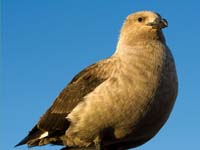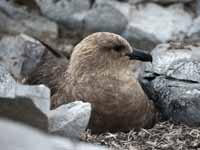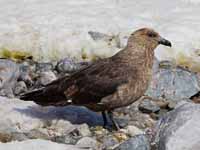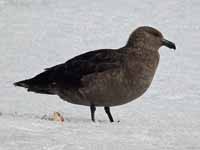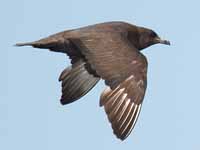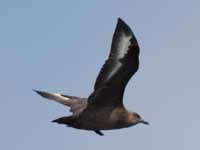THE WORLD BIRDS - An Online Bird Book
GULLS and Allies
SKUAs
Order Charadriiformes Family Stercorariidae
GULLS and Allies
Gulls, terns, skimmers, skuas, puffins, and their allies belong to the order Charadriiformes. Charadriiformes is a diverse order and contains many other families. Most live near water and eat invertebrates or other small animals; however, some are pelagic (seabirds), some occupy deserts and a few are found in thick forest.
SKUAs
Order Charadriiformes Family Stercorariidae
Skuas are in general medium to large birds, typically with gray or brown plumage, often with white markings on the wing. On average, a skua is about 56 cm and 121 cm across the wings. They have longish bills with a hooked tip, and webbed feet with sharp claws. They look like large dark gulls. The skuas are strong, acrobatic fliers. They are generally aggressive in disposition. Potential predators who go near their nest will be quickly dived at by a parent skuas. They will chase gulls, terns and other seabirds to steal their catches, regardless of the size of the species attacked (up to 3 times heavier than the attacking skua). The larger species also regularly kill and eat adult birds. On the breeding grounds they commonly eat the eggs and young of other birds. [abstracted from Wikipedia]
Genus Stercorarius
The skuas are a group of seabirds with about seven species forming the family Stercorariidae and the genus Stercorarius. The three smaller skuas are called jaegers in the Americas. Skuas nest on the ground in temperate and Arctic regions, and are long-distance migrants.
Skua, Brown Stercorarius antarcticus Found: South America, Afica, south Asia, and the Antarctic Region
The Brown Skua is predominantly in Southern Hemisphere. It breeds in the subantarctic and Antarctic zones and moves further north when not breeding.
Similar to: Chilean Skua. Chilean Skua has a dark cap; Brown Skua does not.
Similar to: Great Skua. Great Skua has darker cap. Brown Squa averages slightly larger than Great Skua.
Image by: 1) Su Yin Khoo - Australia 2, 4) David Cook - Australia 4) Nick Athanas - Argentina 5) Winfried_BruenkenSimilar to: Chilean Skua. Chilean Skua has a dark cap; Brown Skua does not.
Similar to: Great Skua. Great Skua has darker cap. Brown Squa averages slightly larger than Great Skua.
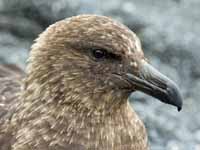
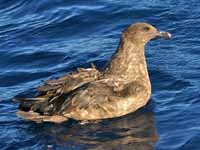
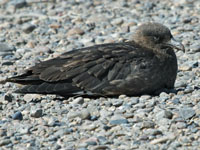
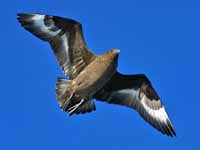
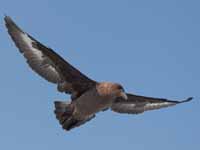
Skua, Chilean Stercorarius chilensis Found: South America
The Chilean Skua breeds in Argentina and Chile. It has a dark cap, cinnamon throat and lower face.
Similar to: Brown Skua. Chilean Skua has a dark cap; Brown Skua does not.
Image by: 1) Arthur Chapman near Ushuaia, Argentina 2) Charlie Westerinen - southern Argentina 3) Nick Athanas - Chile 4, 5, 6)
dFaulder near Ushuaia, ArgentinaSimilar to: Brown Skua. Chilean Skua has a dark cap; Brown Skua does not.
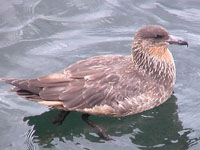
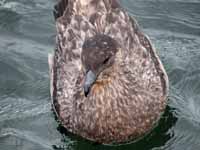
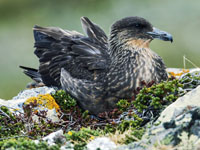
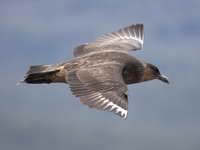
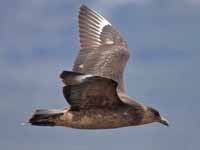
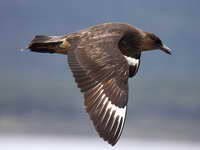
Skua, Great Stercorarius skua Found: The Americas, Europe, Asia, Africa
The Great Skua is predominantly in Northern Hemisphere. It is streaked gray-brown with a dark cap. It is closely related to the Brown Skua and Chilean Skua.
Similar to: Brown Skua has darker cap. Brown Squa averages slightly larger than Great Skua.
Similar to: Long-tailed Skua, Parasitic Skua, Pomarine Skua. Great Skua has gray brown back, these others skuas do not.
Similar to: South Polar Skua. Great Skua is larger than South Polar Skua. Great Skua has a dark cap; South Polar Skua does not.
Image by: 1) Dick Daniels- Featherdale Wildlife Park, Australia 2, 4) Andreas Trepte 3) Bill Bouton - Scotland 5) Dick - Scotland 6) Charlie Westerinen - close to Surtsey Island at IcelandSimilar to: Long-tailed Skua, Parasitic Skua, Pomarine Skua. Great Skua has gray brown back, these others skuas do not.
Similar to: South Polar Skua. Great Skua is larger than South Polar Skua. Great Skua has a dark cap; South Polar Skua does not.
1) Juvenile
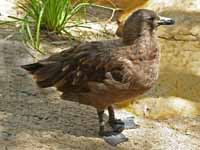
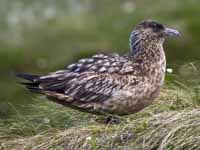
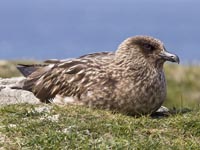
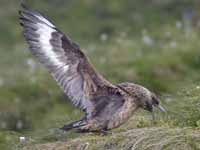
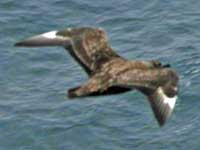
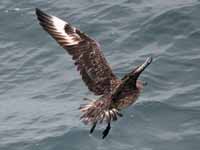
Skua, Long-tailed also Long-tailed Jaeger Stercorarius longicaudus Found: The Americas, Europe, Asia, Africa, Australia
The adult Long-tailed Skua has a gray back; dark primary wing feathers; black cap; white neck and underparts; gray flanks; very long tail.
Similar to: Great Skua. Great Skua has gray brown back, Long-tailed Jaeger does not.
Similar to: Pomarine Skua, Parasitic Skua. In breeding season, adult Long-tailed Skua can be identified by its long tail. Long-tailed Skua does not "flash white" wings while flying, these other skuas have white wing flash.
Image by: 1, 2) Marcel Holyoak - California 3) Jerzy Strzelecki Stephen Clegg - Norway 5, 6) US
of the Fish and Wildlife ServiceSimilar to: Great Skua. Great Skua has gray brown back, Long-tailed Jaeger does not.
Similar to: Pomarine Skua, Parasitic Skua. In breeding season, adult Long-tailed Skua can be identified by its long tail. Long-tailed Skua does not "flash white" wings while flying, these other skuas have white wing flash.
1, 2) Juvenile

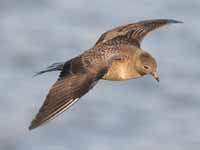
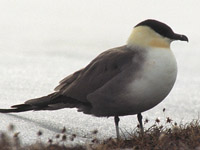
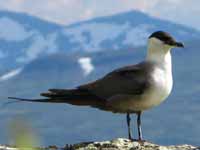

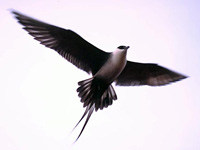
Skua, Parasitic also Arctic Skua also Parasitic Jaeger Stercorarius parasiticus Found: North America, Europe, Asia, Africa, Australia
The Parasitic Skua breeds in the circumpolar arctic tudra. It winters at sea in southern oceans.
Similar to: Great Skua. Great Skua has gray brown back, Parasitic Skua does not.
Similar to: Long-tailed Skua. In breeding season, adult Long-tailed Skua can be identified by its long tail. Long-tailed Skua does not "flash white" wings while flying, Parasitic Skua has white wing flash. Juveniles are difficult to distinguish.
Similar to: Pomarine Skua. Pomarine Skua base half of bill is darker than tip of bill; Parasitic Skua has completely dark bill.
Image by: 1) Bill Bouton - California 2, 3) Tony Morris 5) Arnstein Ronning - Norway 4) Charlie Westerinen - Svalbard , Norway 6) Art
Sowls of the USFWS 7) Per Harald Olsen - Svalbard, Norway 8) Indyhoose - Handa Island, ScotlandSimilar to: Great Skua. Great Skua has gray brown back, Parasitic Skua does not.
Similar to: Long-tailed Skua. In breeding season, adult Long-tailed Skua can be identified by its long tail. Long-tailed Skua does not "flash white" wings while flying, Parasitic Skua has white wing flash. Juveniles are difficult to distinguish.
Similar to: Pomarine Skua. Pomarine Skua base half of bill is darker than tip of bill; Parasitic Skua has completely dark bill.
1) Light juvenile 2, 3) Light breeding adult 8) Dark phase
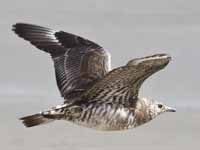
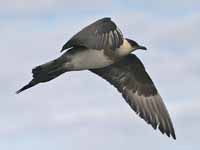
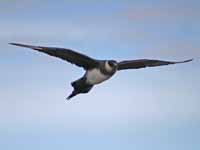
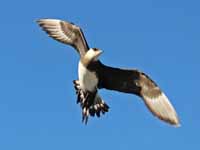
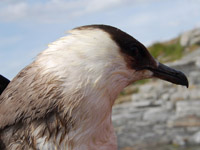
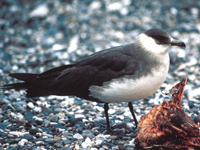
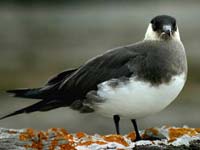
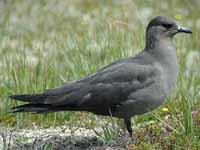
Skua,_Pomarine also Pomarine Jaeger Stercorarius pomarinus Found: North America, Europe, Asia, Africa, Australia
Pomarine Skua breeds in the circumpolar arctic tudra. It winters at sea in southern oceans.
Similar to: Great Skua. Great Skua has gray brown back, Pomarine Skua does not.
Similar to: Long-tailed Skua. In breeding season, adult Long-tailed Skua can be identified by its long tail. Long-tailed Skua does not "flash white" wings while flying, Parasitic Skua has white wing flash. Juveniles are difficult to distinguish.
Similar to: Parasitic Skua. Pomarine Skua base half of bill is darker than tip of bill; Parasitic Skua has completely dark bill.
Image by: 1) Jomilo75 2) Andrei Taranchenko - Barrow, Alaska 3) Nick Athanas - Mexico 4) Continus - North Carolina Gulf Stream Similar to: Great Skua. Great Skua has gray brown back, Pomarine Skua does not.
Similar to: Long-tailed Skua. In breeding season, adult Long-tailed Skua can be identified by its long tail. Long-tailed Skua does not "flash white" wings while flying, Parasitic Skua has white wing flash. Juveniles are difficult to distinguish.
Similar to: Parasitic Skua. Pomarine Skua base half of bill is darker than tip of bill; Parasitic Skua has completely dark bill.
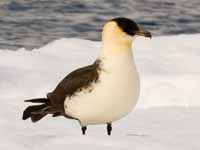
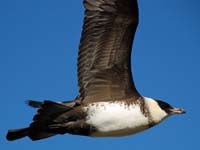
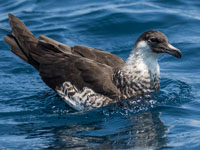

Skua, South Polar Stercorarius maccormicki Found: The Americas, Asia, Africa, Australia
The South Polar Skua breeds on the Antarctic coasts; winters in the Pacific, Indian, and Atlantic Ocean. It is gray brown with paler underparts and head.
Similar to: Great Skua. Great Skua is larger than South Polar Skua and has a dark cap; South Polar Skua does not.
Image by: 1) Samuel
Blanc 2) Alistair Knock 3) doevos
4) Charlie Westerinen - Niko Landing in the Antarctica 5) Julio Mulero - California 6) Marcel Holyoak - California4, 5) Dark morph
